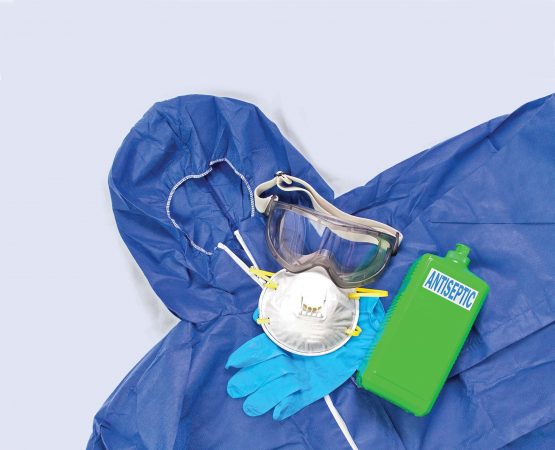
Change of routine: Managing plant safety in the COVID-19 era
By CCOHS
Industry Manufacturing CCOHS COVID manufacturing SafetyHardwire comprehensive measures into workplace routines as production ramps up.

Personal protective equipment.
PHOTO: Stanislau_V – stock.adobe.com
While many manufacturers closed due to the COVID-19 outbreak, had employees working remotely or reduced their staff, businesses are returning to more normal production. However, new norms will replace established routines. Employers need to be prudent and careful while adhering to public health measures and legislation to ensure the health and safety of team members, customers and the public.
New COVID-19 infections are possible, but infection rates have slowed enough for the health care system to handle probable cases. If rates increase, another period of more restrictive measures could be reintroduced, and workplaces will need to adjust accordingly.
Following a deep cleaning of the facility before workers return, put heightened sanitation practices in place. Make sure washrooms are cleaned frequently and are stocked with soap, paper towels and a plastic-lined waste container. Provide workers with wipes or ways to clean their workspace, and provide hand sanitizer in common spaces, entrances and exits. Additionally, lunchrooms, workspaces and other shared spaces should be cleaned at least once daily, and more often for high-traffic areas and high contact surfaces. Focus on frequently touched and shared surfaces such as keys, doors, handles, phones, tables, chairs and equipment.
Protect the health and safety of workers by providing adequate information, training, sanitation and personal protective equipment. Set a clear policy for what is expected of workers if they get sick, have symptoms, or if exposure is reported. Communicating policies, measures and ensuring employees know how to minimize the spread of COVID-19 is key.
Post signs to remind people to practice physical distancing, good respiratory etiquette and hand hygiene. Provide enough items such as phones, tablets, walkie-talkies and tools for each worker to avoid unnecessary sharing. If items must be shared, clean them with alcohol wipes or disinfectant when they change hands.
Some changes to operations may be required to accommodate physical distancing. Evaluate what changes can be made, such as installing plexiglass or other barriers. Stagger shifts to minimize the number of workers in one place. And consider how people will use shared spaces such as the cafeteria, lunchroom, hallways, changing rooms and washrooms. Keep close contact to a minimum and less than 15 minutes.
Allow only one person at a time if spacing can’t be maintained and post signs to indicate the space is being used. Designate travel paths so workers don’t have to pass each other closely in hallways, corridors or stairwells. Indicate pedestrian traffic flow with markings, posters or barriers. Adjust production outputs and schedules may need to be adjusted to reflect the necessary changes.
Wearing masks
Non-medical masks worn correctly can be used when physical distancing is not possible or difficult to maintain. They help slow the spread of the virus by reducing respiratory droplets dispersed when people talk, sneeze or cough.
Each person will have a different reaction to the pandemic, physical distancing and isolation measures. Some will be ready to reintegrate into everyday activities, while others may wish to exercise caution and continue to practice physical distancing. Provide information and reassurance about the measures taken and address any anxiety or fear that may be expressed. And workplaces will need to be compassionate when a team member is grieving over the loss of a friend or family member.
While many people recover from COVID-19 without hospitalization, estimates are one in six become severely ill. Those who required intensive care may continue to be challenged by muscle weakness, and problems with memory and concentration. In some cases, it may take a long time for a person to return to work. Collaboration with the worker will be necessary to develop and support an appropriate accommodation plan.
Every business is unique and there is no one-size-fits-all approach for workplace safety. Follow the necessary physical distancing or safety measures, monitor announcements for your area, and follow the latest instructions from the government, public health or other appropriate authority.
The Canadian Centre for Occupational Health and Safety (CCOHS) in Hamilton contributed this article. CCOHS provides information, training, education, management systems and solutions that support health and safety programs and the prevention of injury and illness in the workplace. Visit www.ccohs.ca.
This article first appeared in the July-August 2020 print edition.
